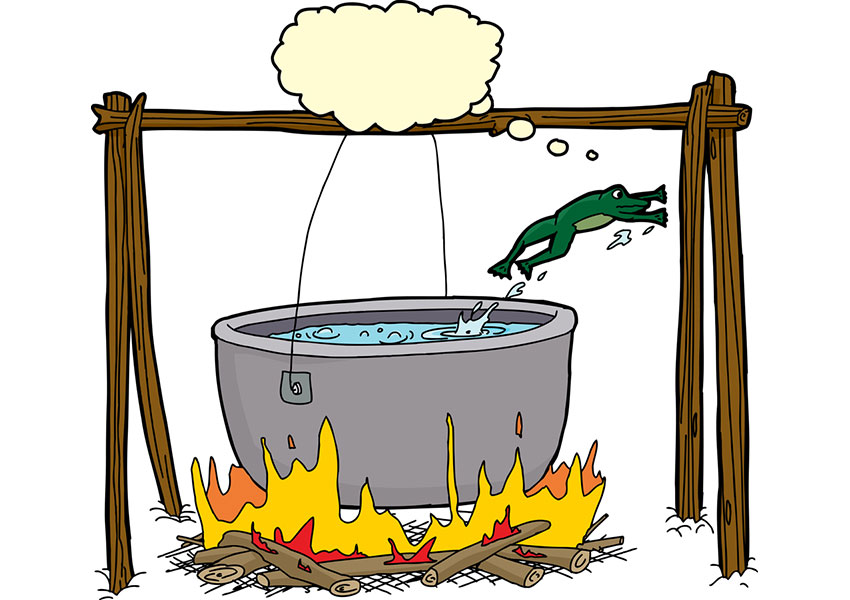How Any Leader Can Avoid Becoming A Frog

Part I of a Series: A Much Needed New Approach to Strat Planning.
Any leader worth their salt knows, and is motivated by, the legend of the frog. Pre-occupied with immediate matters, he was inattentive to changes heating up around him. It was as incredibly costly mistake.
The moral of the story? Leaders must never lose sight of their core responsibility: anticipating the future and addressing potential issues and opportunities early enough to keep themselves, their operations and their stakeholders’ dreams viable. Whether a member of the C-Suite, a board director, department head or team leader, here’s a checklist so you don’t suffer the frog’s fate.
- Devote lots of time to thinking about the future:
When speaking at The London Business School, Peter Hinssen was adamant about this: “Most organizations allocate 90% of their efforts to ‘today’ with the rest going to ‘tomorrow.’ This means the ‘day after tomorrow’ gets nothing. Although today generates your current value, when plans for your future value don’t extend beyond tomorrow you won’t make it there. It’s that simple. What distinguishes category kings and paradigm shifters from others is that they devote lots of time to day after tomorrow thinking.” - Have as your top focus strategic planning.
A recent study published in the Harvard Business Review reveals that companies where leaders prioritize planning for the day after tomorrow outperform their peers. Researchers found that executives of top performing companies didn’t spend any more time on their work than those at other companies – they just spent it quite differently: They were more forward-looking; more focused on creating future value; more likely than the broader executive population to list strat planning as their top focus. - Whatever the method used by your organization for strat planning, before deploying it again assess it for the ways it may be leaving you and your organization vulnerable.
Among findings of a recent 2-year study by Lindsay Foresight & Stratagem:
– In many organizations, the planning process is not even codified. The result is an approach without much rigor.
– Many executives presume they’re doing strategic planning when it is really only annual operational planning. Not knowing the difference their organizations are not getting the “future-proofing” they think they are.
– Current strat planning approaches are frankly antiquated; held over from a time when the pace of change was slower, performance metrics were much different, and the business world less complex. That they are now ineffectual makes them a waste of time and resources. But worse than that, these out-of-date approaches actually increase the existential threat a company faces the day after tomorrow. (Research by Lindsay Foresight & Stratagem actually led to the development of a ‘new and improved’ approach to strat planning – relevant to the times. Now vetted and tested, those using it testify to its efficacy and ease of use. Learn it here.) - In whatever pot you find yourself (company, category, responsibility), don’t just take the water’s temperature now. Forecast it 3 to 5 years into the future. Why?
Because to create the future as you’d like it to be requires a strat plan that accounts for the emerging customer and marketplace dynamics that will cause your circumstances to heat up if not addressed before it’s too late. Almost everyone today is accounting for climate change, privacy and cybersecurity. But other dynamics, less well-known, also present big implications for every organization; every executive and employee as well. In aggregate, they present what the World Economic Forum says is “a revolution that will fundamentally alter the way we live, work and relate to one another. In its scale, scope and complexity, the transformation will be unlike anything humankind has experienced before.” This is a future for which Deloitte and others say few are prepared. It’s in great part because so many leaders are not aware of these less-famous dynamics and their implications. It’s critical that all involved in planning an organization’s future be familiar with them. They not only inform the urgency with which you should jump. They also inform the direction of your leap. - Give considerable thought to what it will take to have your colleagues leap out of the pot with you, at the same time and in the same direction.
This wisdom comes from an under-reported part of the frog’s story: Not only did the frog not move from the pot, but those he was leading followed his example and remained in the pot with him. So the tragedy of the frog’s inaction is actually far bigger than previously realized.
– The insight? A leader’s responsibility of early identification and action on future issues and opportunities includes leading others to see and act on this future, too.
– A second insight: While the hardest thing about being a leader is anticipating the future early enough to try and insure one’s fate, the second hardest is aligning people to see what you see, and, taking confidence from each other—make the leap together. - Expect the day after tomorrow to arrive early.
Many organizations consider strat planning something to be done every couple of years. Or mid-summer with a view of tweaking a plan for the following fiscal year. Whatever your thinking on when to begin, scrap it. Instead, start now. Even the new and improved strat planning process (referred to above, which is better suited for the pace of today’s change) requires 4 -5 months for completion. But even in those 4-5 months, any pot in which a leader is stewing will be heating up from the exponential pace of change, discoveries, disruptions, innovations, growth opportunities, threats, competitors. Frogs consistently assume them to be years away. But real leaders know they easily arrive ahead of schedule. Real leaders know that at the core of their responsibility is anticipating them early enough to keep their jobs, operations and stakeholder aspirations viable.
Interested in more study findings that can keep you out of hot water? More on the new and improved approach to strat planning? Find them here or get in touch here.
Commentary by Marsha Lindsay.
Bring the best of the CEOWORLD magazine's global journalism to audiences in the United States and around the world. - Add CEOWORLD magazine to your Google News feed.
Follow CEOWORLD magazine headlines on: Google News, LinkedIn, Twitter, and Facebook.
Copyright 2025 The CEOWORLD magazine. All rights reserved. This material (and any extract from it) must not be copied, redistributed or placed on any website, without CEOWORLD magazine' prior written consent. For media queries, please contact: info@ceoworld.biz









